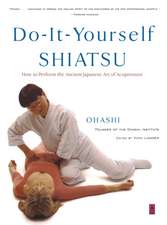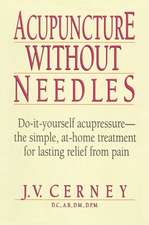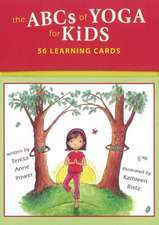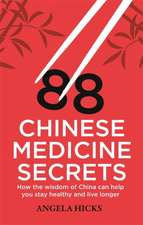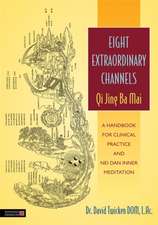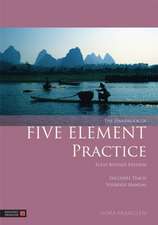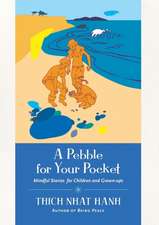Acupressure for Emotional Healing
Autor Michael Reed Gach, Beth Ann Hanningen Limba Engleză Paperback – 20 mai 2005
Acupressure stimulates the same points used in acupuncture, but instead of needles, firm finger pressure is used on the surface of the skin. The pressure releases neurochemicals called endorphins that relieve pain. As in acupuncture, specific pressure points are connected with internal organs and energy pathways in the body (called meridians) that regulate the flow of electrical energy to all systems. Unlike acupuncture, acupressure can be used safely by anyone, with only the hands as equipment.
ACUPRESSURE FOR EMOTIONAL HEALING offers a comprehensive A-Z guide to emotional ailments (from abandonment to worry and obsessive thinking), with fully-illustrated instruction on dozens of precise acupressure point locations and how to activate them, combined with yogic breathing, stretching, and movement routines. Case histories from the authors' practice further illuminate each condition and the path to emotional balance and healing. Most routines can be used independently for self-care and on-the-spot relief. There are also sections on how to use the techniques to help others, with appropriate safeguards.
Preț: 110.42 lei
Preț vechi: 129.26 lei
-15% Nou
Puncte Express: 166
Preț estimativ în valută:
21.13€ • 22.06$ • 17.49£
21.13€ • 22.06$ • 17.49£
Carte disponibilă
Livrare economică 14-21 martie
Livrare express 27 februarie-05 martie pentru 54.97 lei
Preluare comenzi: 021 569.72.76
Specificații
ISBN-13: 9780553382433
ISBN-10: 0553382438
Pagini: 320
Ilustrații: Illustrations
Dimensiuni: 185 x 231 x 20 mm
Greutate: 0.64 kg
Editura: Bantam
Locul publicării:United States
ISBN-10: 0553382438
Pagini: 320
Ilustrații: Illustrations
Dimensiuni: 185 x 231 x 20 mm
Greutate: 0.64 kg
Editura: Bantam
Locul publicării:United States
Notă biografică
Michael Reed Gach, PhD, Dipl ABT, founded the Acupressure Institute in 1976, one of the leading international training schools in Asian bodywork. Gach is a national expert on acupressure therapy and has taught over 100,000 people from all over the world. He is also the originator of Acu-Yoga, a self-healing system of exercises that integrates acupressure and yoga. Gach received his PhD from Columbia Pacific University in health and human services.
Beth Ann Henning, Dipl ABT, is the founder and director of Tao Institute Inc., located in St. Cloud, Minnesota. She has studied with various teachers and spiritual leaders, and holds certifications in various modalities including Jin Shin Jyutsu practitioner, Reiki, acupressure therapy, herbology, Acu-Yoga, Shotakan karate, Shazen somatic therapies and esoteric theory.
Beth Ann Henning, Dipl ABT, is the founder and director of Tao Institute Inc., located in St. Cloud, Minnesota. She has studied with various teachers and spiritual leaders, and holds certifications in various modalities including Jin Shin Jyutsu practitioner, Reiki, acupressure therapy, herbology, Acu-Yoga, Shotakan karate, Shazen somatic therapies and esoteric theory.
Extras
1
Acupressure for Emotional Well-Being
What Is Acupressure?
More than five thousand years ago the Chinese discovered that by applying pressure with their fingers and hands to specific points on the body, they could relieve pain. Through instinct, trial and error, and methodical observation, they identified hundreds of acupressure points that could be used to alleviate physical symptoms, benefit the healthy functioning of internal organs, and balance the emotions.
Acupressure stimulates the same points as acupuncture, but instead of needles, it uses the gentle but firm pressure of the hands to release muscular tension, promote the circulation of blood, and stimulate the body's natural self-curative abilities. Acupressure reaches to the core many of the emotional disorders and stress-related physical problems that typify our contemporary world. By freeing unresolved emotional experiences stored in the body, acupressure can alleviate a wide range of everyday aches and pains, allergies, poor circulation, sleeplessness, and other chronic complaints. It can even unveil the memory of a traumatic experience that caused an emotional wound.
For years Sally complained about being anxious and tense, which resulted in recurring headaches. As a store manager at age thirty-four, she was finding her emotional stress and physical complaints severely draining. She had chronic tension in her neck and a curvature in her upper back. Her relationship with her boyfriend was stressful and further exacerbated her pain. She felt overwhelmed; making decisions was especially difficult.
Sally took an acupressure class, where she learned points to relieve her pain at home. As she held her neck and the pressure points under the base of her skull with her eyes closed, she remembered a fight with a boy in second grade: he had pushed her back so abruptly that her neck was traumatized with whiplash. She recalled how her head filled with pressure as her teacher reprimanded her in front of the class. Since then she had suffered from anxiety attacks and head pain. Holding the acupressure points on her own neck enabled Sally to recall and reexperience the source of her trauma. She began seeing a psychotherapist and a bodyworker. One month after practicing self-acupressure twice a day, she reported that her neck tension, headaches, and anxiety had dissipated; she felt clearer, empowered, and more self-reliant.
Acupressure relaxes the tight muscles that result from an emotional trauma. A traumatic event causes the body to contract its muscles and harden, like protective armor, to shield the inner self. For instance, when something frightens you or someone uptight treats you abrasively, your neck and shoulders may tighten immediately in response. This tension prevents energy from circulating freely in your body. As a result, your body may overreact and shut down, causing various physical ailments and emotional imbalances. If you do not deal with these tensions and resulting afflictions, emotional problems may resurface. Most therapies address the cognitive and emotional aspects of trauma but do not get to the physiological component. Acupressure has an advantage over these therapies in that its techniques work directly with the body that has been affected by the trauma.
Emotional imbalances and the physical symptoms that accompany them are often the body's response to unresolved issues and events. A tension headache, for instance, may be caused by a conflict at work or an argument over homework with one's teenager. Someone who witnessed a fatal automobile accident may live with the memory of burning bodies and twisted metal in the form of recurring nightmares and insomnia; if left untreated they can continue for years. Divorce, even when it seems amicable, is a life-changing transition that can cause both emotional problems (like anxiety, worry, and moderate depression) and physical symptoms (such as stomachaches, ulcers, irritable bowel problems, and more).
Brenda, a forty-two-year-old computer programmer, went for an acupressure session because she had been suffering from insomnia and anxiety ever since her bitter divorce three years earlier. The divorce process was a series of traumatic, emotionally painful experiences. She felt drained and depressed, but she didn't have a history of depression, and she didn't think depression ran in her family. Her doctor prescribed Prozac for the depression and Xanax for her nervousness and fatigue. She tried biofeedback to help her relax, and cognitive-behavioral therapy to deal with her constant negative thoughts. She found that neither the medications nor the various other therapies she tried transformed her ongoing depressed state of mind. Her depression fluctuated between apathy and despair.
Finally, Brenda took a friend's advice and got in touch with Michael Gach. During the first sessions, they worked on her back, and in her abdomen. Michael showed her emotional balancing points on her upper neck and chest for the anxiety-related headaches, and upper back exercises and ankle points for the insomnia. After using self-acupressure and breathing exercises daily for a month, Brenda felt more relaxed and self-reliant. Holding the points in her upper neck, reduced the frequency and severity of her headaches. After three months of self-treatment her sleep improved, she had more energy, and a decrease in her anxiety. Acupressure released most of the tension that Brenda had accumulated and carried in the aftermath of her marital split, making emotional resolution possible. In addition, she gained a renewed connection with her body, restoring her vitality and touching her aliveness.
Our bodies are constantly making adjustments to accommodate the demands (some would say unnatural demands) of modern technology. People who work at their desks, typing away at a computer keyboard and straining their eyes to see the screen, are no strangers to headaches, tense shoulders, stiff neck, backaches, shallow breathing, and repetitive injuries like carpal tunnel syndrome.
Television, computers, and video games are also major causes of the obesity epidemic. Poor eating habits, stress in the workplace or at home, chronic muscular tension, lack of exercise, and bad posture contribute to lethargy, depression, and apathy. Acupressure can rebalance your body and enable you to cope with the demands of modern life.
Foundations of Acupressure & Emotional Healing
Using this natural healing art has no side effects. Your hands are the only equipment you need. The art of acupressure utilizes the sensitivity of the human hand to release endorphins, your body's natural pain-relieving chemicals. These neurochemicals are released by your pituitary gland and get distributed through the cerebrospinal fluid into the bloodstream. Simply holding certain points with steady, firm pressure for a few minutes will release these pain-relief agents. We believe that endorphins also play an important role in cultivating both physical and emotional healing.
Tension and pain accumulate at acupressure points. As a point is held, muscular tension yields to finger pressure, enabling the fibers of the muscle to elongate and relax, blood to flow freely, and toxins to be released and eliminated. When blood and bioelectrical energy circulate properly, you have a greater sense of harmony, health, and well-being. As a result, your symptoms are alleviated, and your circulation is increased sufficiently to restore well-being.
Acupressure points have a high electrical conductivity at the surface of the skin. Holding a point allows life energy to flow through the body. Traditional Chinese medicine refers to this energy as chi (pronounced chee); in Japan it is known as ki (pronounced key). Western scientists have proven the existence of this energy by using microvolt meters, high-tech electrical devices that measure energy and electrical charge throughout the body.
Meridians are the energy pathways that connect acupressure points to one another and to the internal organs. Just as blood vessels nourish the body physically, meridians circulate healing energy to all systems of the body. There are twelve bilateral meridians that run along both sides of the body and relate to specific organs, and eight extraordinary vessels. These pathways are a master communication system of universal life energy, connecting the organs with all sensory experiences.* An acupressure point in one part of the body can send a healing message to other parts of the body through the meridians. Applying pressure on certain points triggers the flow of energy through the meridian pathway. We call these trigger points because they are at a distance from the area they benefit.
The limbic system, a group of structures in the forebrain, has been called the center of our emotions. The limbic system requires energy to flow through the meridians to function properly, but stress and emotional disturbances inhibit the circulation of energy. The resulting tensions accumulate at acupressure points. As tension from stress builds or becomes chronic, blood circulation decreases, inhibiting body functions. Tightness in the chest can make breathing difficult. Using acupressure points on the chest can free breathing, reduce chest pain, and relieve depression. The balancing point on the center of the breastbone, for instance, is good for relieving dizziness and chest constriction, benefiting the cardiovascular system and calming the emotions.
In this book, you will find acupressure points used for a variety of emotional problems, many of which present themselves as physical symptoms. For instance, as you hold points underneath your skull to relieve a headache or insomnia, an insight may come that shifts your state of mind and thereby alleviates your anxiety. As you continue to open your body's energy by using acupressure, greater health, mental clarity, and an expanded awareness will occur, dissolving conflicts between mind and body.
*Harriet Beinfield, LAc, and Efrem Korngold, LAc, OMD, Between Heaven and Earth: A Guide to Chinese Medicine (New York: Ballantine, 1991).
Acupressure for Emotional Well-Being
What Is Acupressure?
More than five thousand years ago the Chinese discovered that by applying pressure with their fingers and hands to specific points on the body, they could relieve pain. Through instinct, trial and error, and methodical observation, they identified hundreds of acupressure points that could be used to alleviate physical symptoms, benefit the healthy functioning of internal organs, and balance the emotions.
Acupressure stimulates the same points as acupuncture, but instead of needles, it uses the gentle but firm pressure of the hands to release muscular tension, promote the circulation of blood, and stimulate the body's natural self-curative abilities. Acupressure reaches to the core many of the emotional disorders and stress-related physical problems that typify our contemporary world. By freeing unresolved emotional experiences stored in the body, acupressure can alleviate a wide range of everyday aches and pains, allergies, poor circulation, sleeplessness, and other chronic complaints. It can even unveil the memory of a traumatic experience that caused an emotional wound.
For years Sally complained about being anxious and tense, which resulted in recurring headaches. As a store manager at age thirty-four, she was finding her emotional stress and physical complaints severely draining. She had chronic tension in her neck and a curvature in her upper back. Her relationship with her boyfriend was stressful and further exacerbated her pain. She felt overwhelmed; making decisions was especially difficult.
Sally took an acupressure class, where she learned points to relieve her pain at home. As she held her neck and the pressure points under the base of her skull with her eyes closed, she remembered a fight with a boy in second grade: he had pushed her back so abruptly that her neck was traumatized with whiplash. She recalled how her head filled with pressure as her teacher reprimanded her in front of the class. Since then she had suffered from anxiety attacks and head pain. Holding the acupressure points on her own neck enabled Sally to recall and reexperience the source of her trauma. She began seeing a psychotherapist and a bodyworker. One month after practicing self-acupressure twice a day, she reported that her neck tension, headaches, and anxiety had dissipated; she felt clearer, empowered, and more self-reliant.
Acupressure relaxes the tight muscles that result from an emotional trauma. A traumatic event causes the body to contract its muscles and harden, like protective armor, to shield the inner self. For instance, when something frightens you or someone uptight treats you abrasively, your neck and shoulders may tighten immediately in response. This tension prevents energy from circulating freely in your body. As a result, your body may overreact and shut down, causing various physical ailments and emotional imbalances. If you do not deal with these tensions and resulting afflictions, emotional problems may resurface. Most therapies address the cognitive and emotional aspects of trauma but do not get to the physiological component. Acupressure has an advantage over these therapies in that its techniques work directly with the body that has been affected by the trauma.
Emotional imbalances and the physical symptoms that accompany them are often the body's response to unresolved issues and events. A tension headache, for instance, may be caused by a conflict at work or an argument over homework with one's teenager. Someone who witnessed a fatal automobile accident may live with the memory of burning bodies and twisted metal in the form of recurring nightmares and insomnia; if left untreated they can continue for years. Divorce, even when it seems amicable, is a life-changing transition that can cause both emotional problems (like anxiety, worry, and moderate depression) and physical symptoms (such as stomachaches, ulcers, irritable bowel problems, and more).
Brenda, a forty-two-year-old computer programmer, went for an acupressure session because she had been suffering from insomnia and anxiety ever since her bitter divorce three years earlier. The divorce process was a series of traumatic, emotionally painful experiences. She felt drained and depressed, but she didn't have a history of depression, and she didn't think depression ran in her family. Her doctor prescribed Prozac for the depression and Xanax for her nervousness and fatigue. She tried biofeedback to help her relax, and cognitive-behavioral therapy to deal with her constant negative thoughts. She found that neither the medications nor the various other therapies she tried transformed her ongoing depressed state of mind. Her depression fluctuated between apathy and despair.
Finally, Brenda took a friend's advice and got in touch with Michael Gach. During the first sessions, they worked on her back, and in her abdomen. Michael showed her emotional balancing points on her upper neck and chest for the anxiety-related headaches, and upper back exercises and ankle points for the insomnia. After using self-acupressure and breathing exercises daily for a month, Brenda felt more relaxed and self-reliant. Holding the points in her upper neck, reduced the frequency and severity of her headaches. After three months of self-treatment her sleep improved, she had more energy, and a decrease in her anxiety. Acupressure released most of the tension that Brenda had accumulated and carried in the aftermath of her marital split, making emotional resolution possible. In addition, she gained a renewed connection with her body, restoring her vitality and touching her aliveness.
Our bodies are constantly making adjustments to accommodate the demands (some would say unnatural demands) of modern technology. People who work at their desks, typing away at a computer keyboard and straining their eyes to see the screen, are no strangers to headaches, tense shoulders, stiff neck, backaches, shallow breathing, and repetitive injuries like carpal tunnel syndrome.
Television, computers, and video games are also major causes of the obesity epidemic. Poor eating habits, stress in the workplace or at home, chronic muscular tension, lack of exercise, and bad posture contribute to lethargy, depression, and apathy. Acupressure can rebalance your body and enable you to cope with the demands of modern life.
Foundations of Acupressure & Emotional Healing
Using this natural healing art has no side effects. Your hands are the only equipment you need. The art of acupressure utilizes the sensitivity of the human hand to release endorphins, your body's natural pain-relieving chemicals. These neurochemicals are released by your pituitary gland and get distributed through the cerebrospinal fluid into the bloodstream. Simply holding certain points with steady, firm pressure for a few minutes will release these pain-relief agents. We believe that endorphins also play an important role in cultivating both physical and emotional healing.
Tension and pain accumulate at acupressure points. As a point is held, muscular tension yields to finger pressure, enabling the fibers of the muscle to elongate and relax, blood to flow freely, and toxins to be released and eliminated. When blood and bioelectrical energy circulate properly, you have a greater sense of harmony, health, and well-being. As a result, your symptoms are alleviated, and your circulation is increased sufficiently to restore well-being.
Acupressure points have a high electrical conductivity at the surface of the skin. Holding a point allows life energy to flow through the body. Traditional Chinese medicine refers to this energy as chi (pronounced chee); in Japan it is known as ki (pronounced key). Western scientists have proven the existence of this energy by using microvolt meters, high-tech electrical devices that measure energy and electrical charge throughout the body.
Meridians are the energy pathways that connect acupressure points to one another and to the internal organs. Just as blood vessels nourish the body physically, meridians circulate healing energy to all systems of the body. There are twelve bilateral meridians that run along both sides of the body and relate to specific organs, and eight extraordinary vessels. These pathways are a master communication system of universal life energy, connecting the organs with all sensory experiences.* An acupressure point in one part of the body can send a healing message to other parts of the body through the meridians. Applying pressure on certain points triggers the flow of energy through the meridian pathway. We call these trigger points because they are at a distance from the area they benefit.
The limbic system, a group of structures in the forebrain, has been called the center of our emotions. The limbic system requires energy to flow through the meridians to function properly, but stress and emotional disturbances inhibit the circulation of energy. The resulting tensions accumulate at acupressure points. As tension from stress builds or becomes chronic, blood circulation decreases, inhibiting body functions. Tightness in the chest can make breathing difficult. Using acupressure points on the chest can free breathing, reduce chest pain, and relieve depression. The balancing point on the center of the breastbone, for instance, is good for relieving dizziness and chest constriction, benefiting the cardiovascular system and calming the emotions.
In this book, you will find acupressure points used for a variety of emotional problems, many of which present themselves as physical symptoms. For instance, as you hold points underneath your skull to relieve a headache or insomnia, an insight may come that shifts your state of mind and thereby alleviates your anxiety. As you continue to open your body's energy by using acupressure, greater health, mental clarity, and an expanded awareness will occur, dissolving conflicts between mind and body.
*Harriet Beinfield, LAc, and Efrem Korngold, LAc, OMD, Between Heaven and Earth: A Guide to Chinese Medicine (New York: Ballantine, 1991).
Descriere
For the millions of people who suffer from insomnia, tension headaches, anxiety attacks, depression, and other stress- or trauma-related problems, this book offers a fast, safe technique for relief that is literally at their fingertips.

